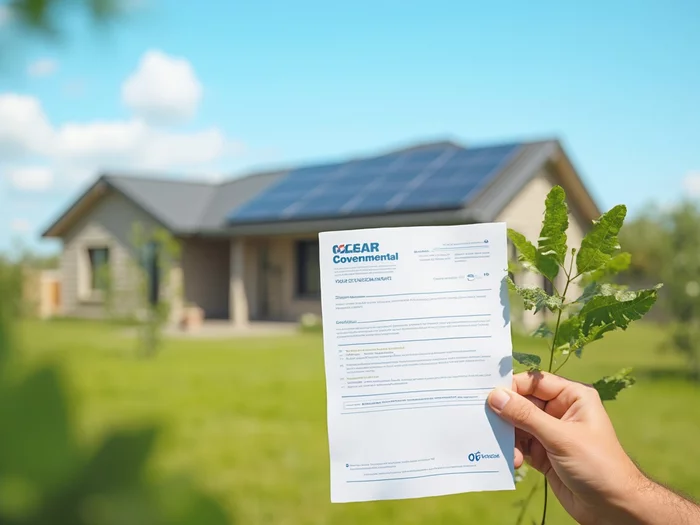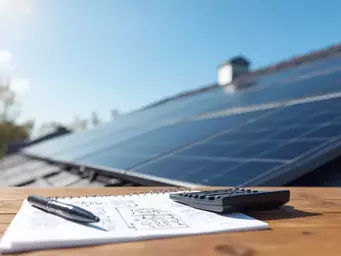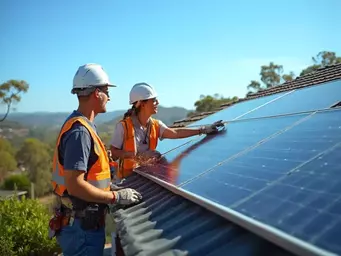Maximising Solar Rebates in Australia

Posted on: 2025-10-13
By: Evelyn Tran
As the renewable energy landscape evolves, many Australian homeowners are discovering the financial benefits of switching to solar energy. What if you could significantly reduce your installation costs and contribute to a cleaner environment at the same time? Understanding solar rebates and government incentives can empower you to make informed decisions about your solar investment.
What You Will Learn
- Solar rebates significantly lower the upfront costs of installing solar systems, making renewable energy more accessible.
- By taking advantage of rebates, homeowners can see a faster return on investment through reduced energy bills.
- Future government incentives in 2025 may include increased rebates for battery storage and enhanced feed-in tariffs.
- The Clean Energy Regulator ensures compliance and aids in distributing solar rebates effectively to eligible homeowners.
- Staying informed about solar incentives can greatly impact your decision-making and potential savings.
Key Australian Solar Rebates and Incentives Overview
This visual summarizes the current and future landscape of Australian government solar incentives, highlighting key programs and their benefits.
Understanding Solar Rebates and Government Incentives in Australia
As a solar energy consultant at Longi Solar Solutions, I often emphasize how crucial solar rebates are for Australian homeowners looking to switch to renewable energy. These incentives can significantly reduce the upfront costs of installing solar systems, making it more accessible for many. By understanding how these rebates work, you can make a much more informed decision about your solar investment!
In the ever-evolving landscape of renewable energy, staying updated on available solar rebates and incentives is vital. The government is committed to promoting solar energy adoption, which translates into substantial financial benefits for those who embrace this sustainable solution. Let's dive deeper into the various segments of solar rebates and what they mean for you!
The Importance of Solar Rebates for Homeowners
Solar rebates not only lower the financial barrier for homeowners but also encourage a broader transition to renewable energy. Some key benefits of these rebates include:
- Cost Reduction: Rebates can cover a significant portion of installation costs.
- Increased Return on Investment: With the savings on your energy bills combined with rebates, homeowners often see faster paybacks.
- Environmental Impact: More solar installations mean a cleaner environment and reduced carbon footprint.
As you can see, taking advantage of these rebates is essential for maximizing your solar system's potential. It's not just about savings; it's about making a positive change for our future!
Overview of Available Government Solar Incentives in 2025
Looking ahead to 2025, the Australian government is expected to introduce several solar incentives aimed at boosting renewable energy uptake. For instance, the government offers various solar energy rebates to encourage homeowners to adopt solar power. Some of the prominent incentives anticipated include:
- Increased rebates for battery storage systems, as detailed on the Energy.gov.au website.
- Enhanced feed-in tariffs for solar energy fed back into the grid.
- New programs targeting low-income households to promote equitable access to solar energy.
These initiatives will help homeowners save money while contributing to Australia’s ambitious renewable energy targets. Staying informed about these incentives is vital, as it can significantly impact your decision-making process.
The Role of the Clean Energy Regulator in Solar Rebates
The Clean Energy Regulator plays a key role in administering and overseeing solar rebates across Australia. They ensure that the programs are effectively implemented and that the incentives reach those who need them most. Some of their responsibilities include:
- Monitoring Compliance: Ensuring that solar installations meet national standards.
- Administering Rebate Programs: Facilitating the distribution of rebates and incentives to eligible homeowners.
- Providing Information: Offering guidance and resources to help homeowners navigate the solar landscape.
The regulator’s work is essential for maintaining the integrity and efficiency of solar rebate programs, which ultimately benefits all Australians looking to invest in solar energy!
Pro Tip
Maximize your solar investment by combining government rebates with energy-efficient practices. For instance, consider integrating energy storage systems with your solar panels. This not only enhances your energy savings but also allows you to benefit from increased rebates for battery storage systems expected in upcoming government incentives. A well-planned approach can significantly shorten your payback period and increase your return on investment!
Summing Up the Benefits of Government Solar Incentives
As we navigate the path toward renewable energy, it’s clear that government solar incentives play a pivotal role in making solar systems more accessible and affordable for Australian homeowners. These incentives not only reduce the upfront costs but also encourage a broader adoption of sustainable energy practices across the nation. By leveraging the available rebates and subsidies, you can significantly increase your potential savings and enhance your return on investment.
In this section, we’ll explore the future of solar rebates beyond 2025 and outline the steps you can take to kickstart your solar journey with confidence!
The Future of Solar Rebates Beyond 2025
The landscape of solar energy incentives is continually evolving, and it’s essential to stay informed about upcoming changes that may affect your investment. While we can't predict everything, we can expect that the government will continue to support renewable energy initiatives. Here are some potential trends for solar rebates moving forward:
- Increased funding for solar panel installations and battery storage systems.
- Expansion of eligibility criteria for rebates, making them accessible to more homeowners.
- Enhanced integration of renewable energy technologies into existing energy grids.
Staying updated with these developments will ensure that you can take full advantage of the available incentives and plan your solar investment strategically.
Next Steps: How to Get Started on Your Solar Journey
If you’re ready to take the plunge into solar energy, the first step is to conduct thorough research about your options. At Longi Solar Solutions, we’re here to help you navigate the complexities and make informed decisions. Here are some steps you can follow to get started:
- Assess your energy needs and goals to determine the right solar system for you.
- Research available solar rebates and incentives in your state.
- Consult with a trusted solar energy consultant (like myself!) to explore system designs and installations.
- Prepare all necessary documentation for the rebate application process.
Taking these steps will put you on the path toward harnessing the power of solar energy, contributing to a more sustainable future while enjoying significant savings!
Frequently Asked Questions about Solar Rebates and Incentives
With the solar landscape changing rapidly, it’s common to have questions about solar rebates and how they work. I’ve compiled some of the most frequently asked questions to help clarify any uncertainties.
What Are the Eligibility Criteria for Solar Rebates?
Eligibility criteria for solar rebates can vary depending on the program and location. Generally, the key factors include:
- Homeownership status: You must own the property where the solar system will be installed.
- System size: There may be maximum limits on the size of the solar system eligible for rebates.
- Installation compliance: The installation must meet local regulations and be performed by a licensed installer.
Checking these criteria can help you understand if you qualify for available incentives.
How Do Feed-in Tariffs Work with Government Incentives?
Feed-in tariffs are an essential part of the solar incentives ecosystem. They allow you to earn money by feeding excess electricity generated by your solar system back into the grid. The interaction with government incentives typically involves:
- Receiving a fixed payment rate for the energy you supply back to the grid.
- Enhancing your savings on electricity bills, as you are effectively using your solar-generated power.
- Potentially increasing your overall return on investment when combined with solar rebates.
This synergy between feed-in tariffs and government incentives can significantly boost the financial benefits of switching to solar energy.
Where to Find More Resources for Your Solar Application
Finding reliable resources is crucial for successfully navigating your solar application process. Some valuable sources include:
- Government websites and portals that detail rebate programs and eligibility guidelines.
- Local solar installation companies that can provide personalized advice and assistance.
- Online forums and communities where solar users share tips and experiences.
By tapping into these resources, you can ensure a smoother application experience and maximize your savings.
Understanding the Role of Energy Providers in Solar Incentives
Your energy provider plays a significant role in the solar incentives landscape. They can affect your experience through:
- Offering specific feed-in tariffs for solar energy exported back to the grid.
- Providing guidance on the best practices for integrating your solar system with their energy services.
- Informing you about any additional incentives they may offer for solar adopters.
Engaging with your energy provider is a vital step in optimizing the benefits of your solar investment!
Recap of Key Points
Here is a quick recap of the important points discussed in the article:
- Solar rebates significantly reduce the upfront costs of installing solar systems.
- Government incentives are expected to expand in 2025, including increased rebates for battery storage and enhanced feed-in tariffs.
- The Clean Energy Regulator ensures compliance and effective distribution of solar rebates.
- Eligibility for rebates typically involves homeownership, system size limits, and compliance with local regulations.
- Engaging with your energy provider can optimize the benefits of solar incentives and feed-in tariffs.
 Ready to unlock the potential of solar energy for your home? Understanding the financial landscape o
Ready to unlock the potential of solar energy for your home? Understanding the financial landscape o
 As you contemplate the shift to solar energy, consider this: a comprehensive understanding of the co
As you contemplate the shift to solar energy, consider this: a comprehensive understanding of the co
 Choosing the right solar installer can significantly impact your renewable energy journey. Are you r
Choosing the right solar installer can significantly impact your renewable energy journey. Are you r
